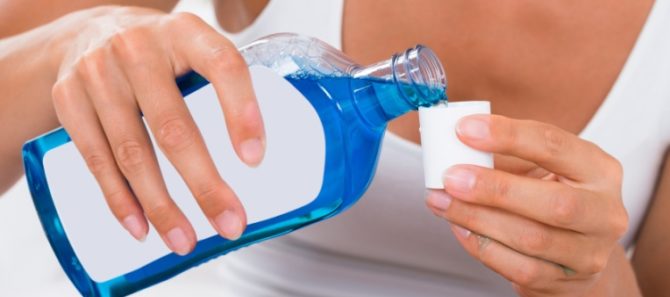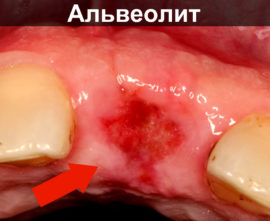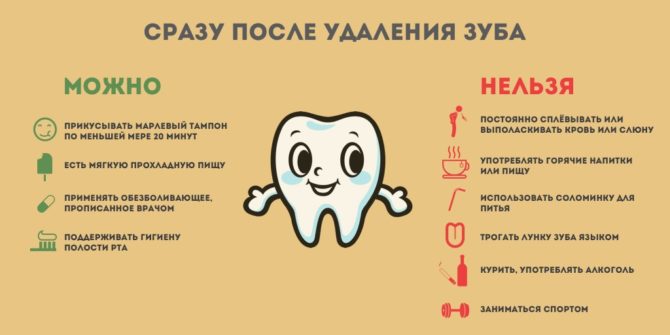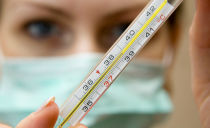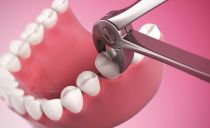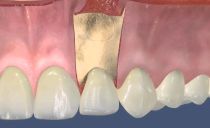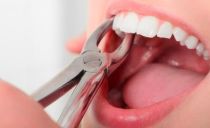How and how to rinse your mouth after tooth extraction for quick healing of the hole
After tooth extraction, you need to eat right and adhere to a number of restrictions. The first two hours you can’t eat and drink, in the future you need to make sure that the food is soft and the drinks are warm. It is impossible to rinse your mouth immediately after tooth extraction so that the hole heals faster. Such actions can lead to the dissolution of a blood clot that isolates the wound from infection. In addition, patients who have recently had a tooth removed should not drink through a straw, smoke, or visit a bathhouse.
Content
- Do I need to rinse my mouth after tooth extraction and why
- How to rinse your mouth with chlorhexidine after tooth extraction
- How else can you rinse your mouth when the tooth is removed
- How many days do you need to rinse your mouth after tooth extraction and why
- The use of herbs for the manufacture of mouthwashes at home
- Rinse the mouth after removing the eights
- Other recommendations to be followed after tooth extraction
Do I need to rinse my mouth after tooth extraction and why
It is possible to rinse your mouth after tooth extraction for faster healing of the socket, but not immediately. After extraction, a blood clot forms in the well, protecting it from the penetration of infectious agents. When rinsing, the formed clot is washed out, which is fraught with the development of a “dry hole” and, as a result, an inflammatory process called alveolitis.
On what day after tooth extraction you can rinse your mouth
Alveolitis is manifested by severe pain, high fever, bad breath and general weakness. A “dry well” can develop within two to three days after tooth extraction, therefore better not to rinse your mouth for the first 48 hours.
After extraction, it is necessary to wait for the formation of a natural blood clot, which will accelerate the healing of the gums and prevent the wound from festering. After two days after tooth extraction, you can do mouth rinses, but you can not carry out the procedure too actively so as not to wash the blood clot.
In the first days after tooth extraction, you can make baths - holding a disinfectant solution in the oral cavity. In contrast to rinsing, oral baths are safer, as they do not threaten leaching of a blood clot.
Rinsing the mouth after removing deciduous and permanent teeth helps to carefully clean and disinfect the postoperative wound. In addition, this procedure ensures the removal of necrotic tissue that exfoliates during the healing process of the well.
Rinsing the mouth after tooth extraction helps to heal the gums as soon as possible and is usually done 4 times a day using warm salt water (1 teaspoon of salt in a glass of warm water). The procedure must be carried out after 48 hours after extraction.
How to rinse your mouth with chlorhexidine after tooth extraction
Within 10-12 days after tooth extraction, it is recommended to rinse your mouth with Chlorhexidine. In the early days, you can do baths with chlorhexidine. This solution perfectly kills bacteria, but when using it, care must be taken not to wash the blood clot.
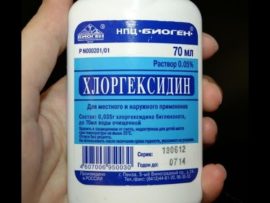 In dentistry using chlorhexidine:
In dentistry using chlorhexidine:
- treat inflammatory processes in the oral cavity;
- disinfect and anesthetize wounds with pus;
- disinfect gums before surgery;
- prevent the development of inflammatory pathologies.
Chlorhexidine can be bought at any pharmacy. The drug is available in the form of an aqueous or alcohol solution.To disinfect the well and not disrupt the healing process, you need to purchase a 0.05% solution of Chlorhexidine in water. A tool with this concentration is recommended to be used by doctors of dental clinics.
Before you start washing the wound, you should brush your teeth: an hour before rinsing. Before using chlorhexidine, you must rinse your mouth to remove all food debris. This can be done using ordinary boiled water at room temperature.
You can rinse your mouth with chlorhexidine for no more than 12 days, then you need to change the drug. You can eat 60 minutes after washing the hole. You can not swallow the drug, if you accidentally get the solution inside, you need to take any absorbent, for example, coal.
How else can you rinse your mouth when the tooth is removed
To prevent infection of the wells, other popular and effective drugs and solutions can be used:
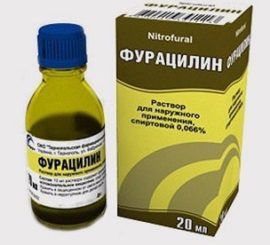 Miramistin. This is an antiseptic with which you can rinse out bacterial particles that precipitate the oral cavity. In addition, the drug neutralizes yeast and even some viruses, increases the body's defenses and helps to quickly heal the wound without penetrating the circulatory system. Miramistin can treat already existing inflammation of the hole. The drug is safe for children and pregnant women.
Miramistin. This is an antiseptic with which you can rinse out bacterial particles that precipitate the oral cavity. In addition, the drug neutralizes yeast and even some viruses, increases the body's defenses and helps to quickly heal the wound without penetrating the circulatory system. Miramistin can treat already existing inflammation of the hole. The drug is safe for children and pregnant women.- Soda and saline solutions. Such funds are able to disinfect and heal the wound, prevent the formation of purulent exudate and flux. To prepare the right solution, you need to take a cup of warm or cool water and add a teaspoon of soda and salt to it. You can also wash the hole with a mixture of 5-6 drops of iodine and a teaspoon of salt dissolved in a glass of water. It is forbidden to rinse the hole with a hot solution, since such an action will lead to the formation of a focus of inflammation and bleeding.
- Furatsilin. To rinse the oral cavity after tooth extraction, a solution of Furacilin can be used. This drug has long been used as an excellent disinfectant that relieves inflammation and stops the formation of pus. It kills most harmful microorganisms, is effective in combating postoperative complications. To make the solution, you need to part two crushed tablets in a cup of hot water, and then add a little salt. For faster dissolution of substances, you can heat the solution over low heat. Rinse the injured gum with Furacilin three to four times a day.
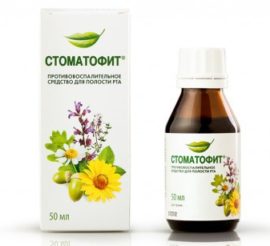 A solution of potassium permanganate. The hole formed after the tooth was pulled out can be rinsed with a solution of potassium permanganate. This drug has long been used in medicine and is the best way to disinfect wounds and eliminate suppuration. To prepare a solution of potassium permanganate, you need to add several grains of the drug to a cup of water and mix the solution until they are completely dissolved. A more concentrated agent can burn the mucous membrane of the oral cavity and provoke the development of an allergic reaction.
A solution of potassium permanganate. The hole formed after the tooth was pulled out can be rinsed with a solution of potassium permanganate. This drug has long been used in medicine and is the best way to disinfect wounds and eliminate suppuration. To prepare a solution of potassium permanganate, you need to add several grains of the drug to a cup of water and mix the solution until they are completely dissolved. A more concentrated agent can burn the mucous membrane of the oral cavity and provoke the development of an allergic reaction.- Stomatophyte. The drug has a pronounced anti-inflammatory, antibacterial and antifungal activity. In addition, it is used as an astringent, they also cure flux. Due to the alcohol included in the preparation, it is not recommended for the treatment of children under 6 years old. To rinse the child's mouth, you need to dilute the drug with water.
- Hydrogen peroxide. The tool can only be used in diluted form. A spoonful of a 3% solution is diluted in 100 ml of water.
Do not use a concentrated peroxide solution to rinse your mouth, otherwise the blood clot will dissolve. The hole in this case heals much longer.
When preparing solutions for oral baths and rinses, it is necessary to observe proportions so as not to harm the process of formation of the hole and the natural healing of the wound.You can rinse your mouth only on the third day after tooth extraction. Procedures should be short (1-2 minutes), but regular (3-5 times a day). It is equally important to carefully follow the instructions for those drugs that must be diluted with water to the desired concentration.
How many days do you need to rinse your mouth after tooth extraction and why
How long it takes to wash the hole depends on the complexity of the extraction and the individual characteristics of the patient. As wound healing progresses, the need for a procedure gradually decreases. Usually it is enough to carry out the recommended actions within a few days.
If the postoperative wound is large and / or deep, for example, when removing the figure eight, particles of food and microorganisms can accumulate in it, which are difficult to remove with the usual mouth rinse. In this case, daily irrigation of the well with a disinfectant solution may be required.
Irrigation of the hole after the tooth is pulled out to the patient is carried out to gently flush the pathogenic microflora, which can:
- slow down the tightening of the hole;
- become a source of bad taste or bad breath;
- create an environment that promotes secondary infection.
The use of herbs for the manufacture of mouthwashes at home
Swollen gum after tooth extraction can be rinsed with decoctions and tinctures of herbs. Despite the fact that herbal decoctions have weak antiseptic properties, they are used for inflammation of the hole in combination with other potent means for rinsing the throat and mouth. To prepare the rinse solution, you can use chamomile, sage, calendula, oak bark. Both their combined use and the brewing of one ingredient are recommended.
To prepare a decoction that can safely rinse the hole after tooth extraction, you need a tablespoon of herbal medicinal raw materials and a cup of boiling water. First you need to brew the grass, and then hold the solution on low heat for 10-15 minutes. When the broth is infused, it is necessary to strain it and cool.
It is forbidden to use herbal decoctions as the only means for the treatment of suppuration in the hole. In such cases, a doctor’s consultation in the dental clinic is required, he will prescribe antibiotics or other stronger drugs to avoid serious complications.
Rinse the mouth after removing the eights
Dentists advise starting to rinse your mouth only on the fourth day after removing the wisdom tooth. It is forbidden to drink alcohol, drink strong tea and other caffeinated drinks. Within 24 hours, it is necessary to carry out the cooling of the operated area of the gum to reduce the risk of severe edema.
It is necessary to rinse the oral cavity with water to clean the open wound and prevent its infection. For this, it is advisable to use an irrigator. You must also rinse your mouth after each meal. After removing the "wise" tooth, it is recommended to rinse the mouth with soda or Chlorhexidine.
Sometimes wounds resulting from extraction cause intense pain that interferes with regular brushing. In this case, doctors advise rinsing your mouth with a solution containing chlorhexidine. This effective antiseptic is often used in dentistry, it is needed to reduce the growth of pathogenic microflora and the intensity of the inflammatory process.
The active substance of Chlorhexidine prevents the formation of plaque, which allows you to replace standard toothbrushing by wiping the enamel with gauze napkins or cotton swabs moistened in this solution.
The use of an antiseptic containing chlorhexidine is prohibited for the first 48 hours after extraction.During this period, in no case should you use an alcohol preparation, because alcohol has a powerful blood-thinning effect. A particularly strong anticoagulant effect of the drug increases the risk of repeated bleeding at the site of removal of the wisdom tooth.
With intense sports training and strong physical stress, pressure rises, so secondary hemorrhages can occur. For this reason, doctors usually prohibit playing sports in the first days after extraction, especially when removing the eight.
Other recommendations to be followed after tooth extraction
So that the healing process of the hole does not last too long, it is necessary not only to rinse your mouth with antiseptics, but also follow other medical recommendations:
- You can’t eat for three hours.
- You can drink only after two hours.
- In order to avoid suppuration of the hole, you need to eat mainly soft, warm food.
Adults are not allowed to drink alcoholic beverages, as they cause a decrease in muscle tone of the vascular wall, which provokes the development of infection and bleeding. For the same reason, hot baths, spa treatments, saunas, sunbathing in the open sun or in a solarium are not recommended.

